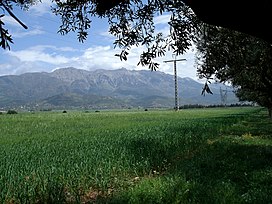
Back Tellatlas Afrikaans الأطلس التلي Arabic Тел Атлас Bulgarian Atles Tell Catalan Tell Atlas CEB Tell Atlas Danish Tellatlas German Άτλας Τελλ Greek Tella Atlaso Esperanto Atlas teliano Spanish
| Tell Atlas | |
|---|---|
 View of the southern slopes of the Haizer Range in the Djurdjura Mountains | |
| Highest point | |
| Peak | Lalla Khedidja |
| Elevation | 2,308 m (7,572 ft) |
| Coordinates | 36°0′0″N 2°0′0″E / 36.00000°N 2.00000°E[1] |
| Dimensions | |
| Length | 1,500 km (930 mi) E/W |
| Width | 115 km (71 mi) N/S |
| Naming | |
| Native name | الاطلس التلي' (Arabic) |
| Geography | |
| Countries | Morocco, Algeria and Tunisia |
| Parent range | Atlas Mountains |
| Geology | |
| Orogeny | Alpine orogeny |
| Rock age | Miocene |
| Rock type | Crystalline metamorphic |
| Climbing | |
| First ascent | unknown |
| Easiest route | drive |

The Tell Atlas (Arabic: الاطلس التلي, al-ʾaṭlas al-tlī) is a mountain chain over 1,500 km (932 mi) in length, belonging to the Atlas mountain ranges in North Africa, stretching mainly across northern Algeria, ending in north-eastern Morocco and north-western Tunisia.
The ranges of this system have an average elevations of about 1,500 m (4,900 ft) and form a natural barrier between the Mediterranean and the Sahara. Its highest summit is the 2,308 m (7,572 ft) high Lalla Khedidja in the Djurdjura Range.[2]
Several large cities such as the Algerian capital, Algiers, with ~1,500,000 residents (2005) and Oran with ~770,000 residents (2005) lie at the base of the Tell Atlas. The Algerian city Constantine with approximately 505,000 residents (2005) lies 80 km inland and directly in the mountains at 650 meters in elevation. A number of smaller towns and villages are situated within the Tell; for example, Chiffa is nestled within the Chiffa gorge.
- ^ Google Earth
- ^ Mamdouh Shahin, Water resources and hydrometeorology of the Arab region, 2007 ISBN 978-1-4020-5414-3
